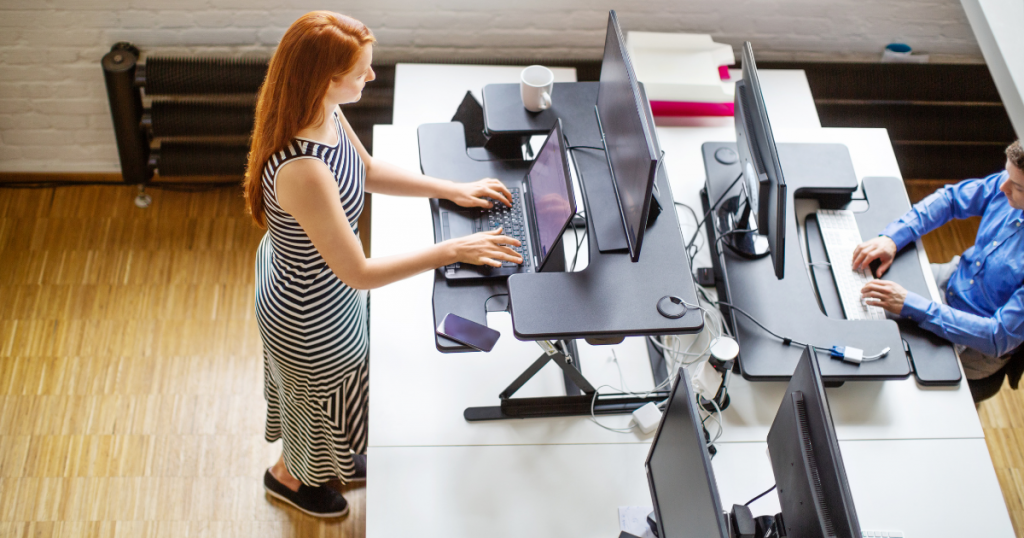Are Standing Desks Better for Posture?
As more and more manual work is taken over by machinery, for many, life at an office desk is on the increase. Of course, as we spend less time outdoors and more time cooped up inside of the office, we generally lead a much more sedentary lifestyle.
Not only can this cause an increase in headaches and problems with eyesight, but it can also lead to bad posture too. When you break down the average time an office worker spends at their desk, the numbers are pretty staggering:
- 6.5 hours a day
- Around 1,700 hours a year
- Roughly 67 days a year in total
In fact, during the duration of their life, the average employee can spend up to 90,000 hours sitting in front of a desk. Sounds a lot, right? Given the sheer volume of time spent at a desk, investing in office furniture that improves our lifestyle (and more specifically our posture) is surely worth it. So, do standing desks help?
The Office Furniture Online team have broken down the benefits of sit-stand and height-adjustable desks, including some handy tips on how to use your desk correctly – and bad habits that you should avoid.

Are Standing Desks Better for You?
In short, yes! Standing desks can be extremely beneficial and improve the quality of your working life, but only when used correctly (we’ll provide more info on that later).
Adults now spend between six and seven hours a day at a desk on average, and that’s without including any recreational time spent on PCs and game consoles when they return home. The thing is, our bodies are not designed to be in a sedentary position for around ⅓ of the day; the limbs, spine and neck are intrinsically linked, and large amounts of time sat static can cause strain on our necks and discs, circulatory problems, muscle degeneration and even weakened bones.
By investing in the likes of a sit-stand or height-adjustable desk, you’re able to dramatically decrease the risk of such symptoms by allowing yourself the option of switching between standing and sitting postures in an instant. This increases your mobility and activity throughout the day while reducing the physical stresses of sitting sedentary for extended periods.
As well as the physical benefits of standing desks, you’ll also find that important factors such as creativity, concentration and productivity to name a few undergo significant improvements. Increased blood flow around the body includes blood flow to the brain, this, in turn, improves the way in which we feel and the way we work. Alongside increasing productivity by up to 10 or 20%.
All of these benefits and more await once you switch up your office furniture, but as we touched upon earlier, you’ll only reap the physical and ergonomic benefits of a standing desk by using it efficiently and effectively.

How to Use a Standing Desk
Though it may sound simple enough, you’d be surprised at just how many people misuse their standing desks and miss out on all of the benefits that this adaptable style of office furniture has to offer.
To help you out, here’s a list of simple steps on how to use a standing desk properly.
- Switch between sitting and standing – Though standing is beneficial and increases blood flow, that’s not to say that standing all day is good for you either! Instead, you should alternate between sitting and standing, experts recommend standing 1 hour for every 1-2 hours spent sitting.
- Take regular breaks – Regular breaks help, even if only for five minutes here and there. Though standing at your desk helps, it also pays to move around, stretch, rest your eyes and take your mind off the task at hand for a bit. Factor in some regular respite into your day, even setting reminders to jog your memory.
- Change the position of your keyboard and mouse – When alternating between sitting and standing, it’s important to remember that the ideal wrist position for your keyboard and mouse will also change. This angle should be extended and tilted upwards while sitting, and if this is not considered while switching positions, you may experience wrist pain and discomfort.
- Use arm supports and anti-fatigue mats – Leading on directly from tip number 3, the use of arm supports can also be extremely beneficial when switching from a standing to a sitting position. These soft pads are ordinarily positioned in front of your keyboard or mouse and are designed to reduce pressure on the wrist. Anti-fatigue mats are also highly recommended, commonly used in product lines or counters, they’re just as effective when employed alongside a standing desk.
- Adjust the position of your desk and screen – Lastly, it’s important to consider the correct desk and computer screen height in relation to your position. Not only will this ensure that you’re more comfortable, but it’ll also minimise the risk of injury too. We suggest searching for information on the best position for your desk and screen based on your height; as a rough guide, it’s recommended that a person at the average height of 5ft 11” should set their standing desk at elbow height, it should stand around 44 inches high and the screen between 20 and 28 inches from the face.
Bad Habits to Avoid
There are plenty of benefits to using a standing desk, but there are also some bad habits that you should avoid getting into as well.
To make sure that you’re using your sit-stand desk the right way and not risking any potential injury to yourself or others, we’ve compiled a list of common mistakes to steer clear of.
- Don’t stand up for too long – Top of the tree and perhaps the most obvious factor to avoid is standing for too long. As aforementioned, the key to getting the most out of your standing desk is to alternate between sitting and standing positions. Too much of anything is a bad thing, and standing for too long can cause strain on your knees and ankles as well as make you feel fatigued.
- Standing on the spot – Many people are under the impression that you should be rooted to the spot while using a standing desk, but this simply isn’t the case. One of the many benefits of the standing desk is that it affords you greater mobility to fully move around and utilise all of the space your desk or working environment has to offer.
- Having your standing desk at the wrong height – As we touched upon in our tips on using a standing desk properly, it’s important that you set your sit-stand desk to the right height in order to feel comfortable and avoid injury. Find the right information with some guide measurements based on your height and have a play around to make sure that you’re happy and comfortable.
- Bad posture – Posture is important in everyday life, but it’s especially important when it comes to using a standing desk efficiently. Standing awkwardly or incorrectly can lessen the amount of time you’re able to stand for or even cause back and neck-based injuries. You should stand with your head back and hips upright, as well as adhere to the correct desk and monitor positions.
- Lack of arm supports and anti-fatigue mats – Tired feet and joint pains are all too common in the office, and such symptoms are a sure sign that you’re using your standing desk incorrectly or without the proper supports in place. Arm supports will save you from any troublesome wrist pain, while anti-fatigue mats mean you’ll have some extra cushion and be able to stand comfortably for longer.

Another important factor in posture is investing in the right kind of office chair. A high-quality chair can make all the difference when it comes to the quality of your working life, so ensure that your choice of seating allows you the proper support and plenty of comfort to boot.
For more helpful office furniture advice and pointers, visit our FAQs page.